South Carolina and roses go hand in hand. Spring-to-fall warmth ensures sun-loving roses do their blooming best, not only once but often several times throughout the year. There are many roses that will grow in the state, but only a handful stand out as trouble-free roses in South Carolina.
Let’s take a look at which roses will perform for rose-loving gardeners. Here are nine trouble-free roses in South Carolina.
South Carolina Rose Growing Zones
Before we jump on the list, let’s talk about growing zones.
South Carolina’s growing zones fall between 7a and 9a, which is hot and rose-friendly, but with its heat comes humidity, which roses do not like much. Humidity leads to mildew and fungus problems, so we’ll look at rose care in South Carolina later.
Always check the growing zones advisory before spending out on roses. It’ll be printed on the plant label.
Without further ado, here are South Carolina’s best trouble-free roses.
1. Carolina Rose
Carolina rose is a native of Carolina and the least troublesome rose a gardener could plant there. It’s a prairie rose often spotted on train tracks, in thickets, and by the roadside. It’s tough, hardy, and very pollinator-friendly.
Some folks think the Carolina rose is a weed, but it’s really a perennial shrub with needle-like thorns. Its three-inch light pink flowers have yellow centers, and its scent is divine. Bees and butterflies agree this is one of the best roses for South Carolina. It’ll bring all the bees to the yard.
However, it is a wild rose, not a cultivated one, so strict rules are required to grow this without a takeover bid. Carolina rose flowers just once on the current year’s growth, so trim it back or hard prune it in late winter or early spring and remove suckers.
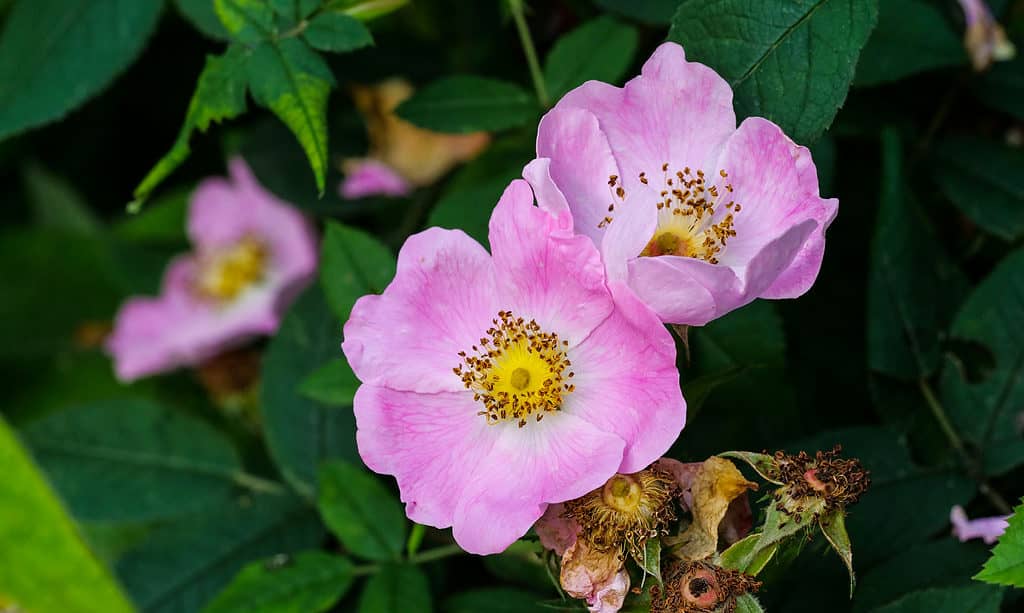
Some folks think the Carolina rose is a weed, but it’s really a perennial shrub with needle-like thorns.
©Brookgardener/Shutterstock.com
2. Lafter
Lafter is an antique 4-inch orange, yellow, and pink double rose that really performs in South Carolina’s gardens. Its long, elegant stems make excellent cut flowers for the house, and because it’s a prolific bloomer, you can cut as many as you want without ruining the bush.
The shrub reaches 4 to 5 feet tall, and its tri-tone blooms emit a fruity scent. Excellent black spot resistance means it’s trouble-free and always covered in lush mid-green foliage.
Gorgeous and tough Lafter is very popular in the Southern U.S.

The shrub reaches 4 to 5 feet tall, and its tri-tone blooms emit a fruity scent.
©Evelyn Tu/Shutterstock.com
3. Cinco de Mayo
The Cinco de Mayo rose is a floribunda with a cluster of reddish-orange frilly blooms. It’s pretty compact so that it won’t take over a border and suits a well-watered container.
This trouble-free rose flowers from early spring right through the summer into fall. Its long blooming season is one of the reasons gardeners grow this beauty. Other reasons are its delicious apple scent and low drama attitude. Cinco de Mayo always performs in South Carolina’s heat.
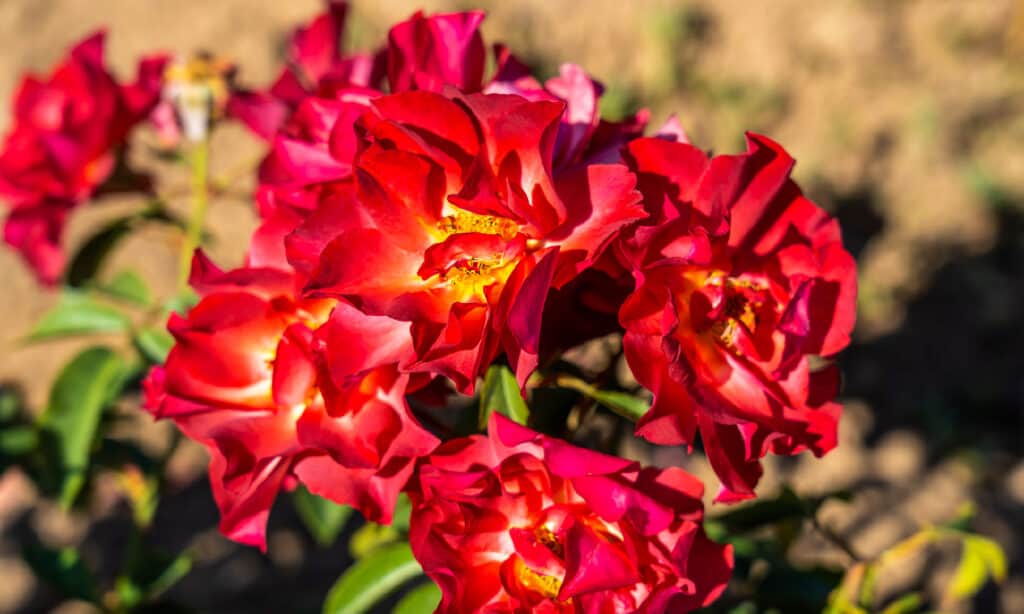
Cinco de Mayo always performs in South Carolina’s heat.
©iStock.com/JHVEPhoto
4. Souvenir de la Malmaison
Souvenir de la Malmaison is a climbing bourbon rose with large, fully double pale pink flowers. It’s a knockout rose that’ll reach 18 feet tall. Some folks describe its pretty bloom as waterlily-like. Its flowers appear almost flat and quartered when the petals are fully open.
Developed in 1843, this beauty is susceptible to rain damage, so it’s a good bet for long, dry South Carolina summers. Northern states shouldn’t go near this dry, summer-loving princess!

Developed in 1843, this beauty is susceptible to rain damage, so it’s a good bet for long, dry South Carolina summers.
©The goldfinch/Shutterstock.com
5. Queen Elizabeth
Queen Elizabeth is one of those award-winning roses that cope with weather extremes. It can easily withstand South Carolina’s heat, and it’s disease-resistant to fight off fungus.
Grandiflora Queen Elizabeth is a gardener’s favorite across the world. Its silvery pink flowers repeat bloom from late spring to fall, emitting a light, sweet scent that isn’t overpowering.
Gardeners who don’t have much time to spend on rose care should plant Queen Elizabeth roses because they require very little maintenance but give so much in return. They are trouble-free roses that complement full sun containers, borders, and balcony gardens.

Grandiflora Queen Elizabeth is a gardener’s favorite across the world. Its silvery pink flowers repeat bloom from late spring to fall.
©iStock.com/yhelfman
6. Marie Pavie
Dwarf polyantha roses love South Carolina’s hot sun and are notably drought-tolerant. Marie Pavie flowers for ten months and repeats blooming its beautiful blush white flowers.
It’s a small bush that reaches 1.5 feet tall, but it packs a punch, emitting a sweet rose scent whenever the sun catches its blooms. Notably disease-resistant and perfect for containers, this is a great rose for South Carolina.
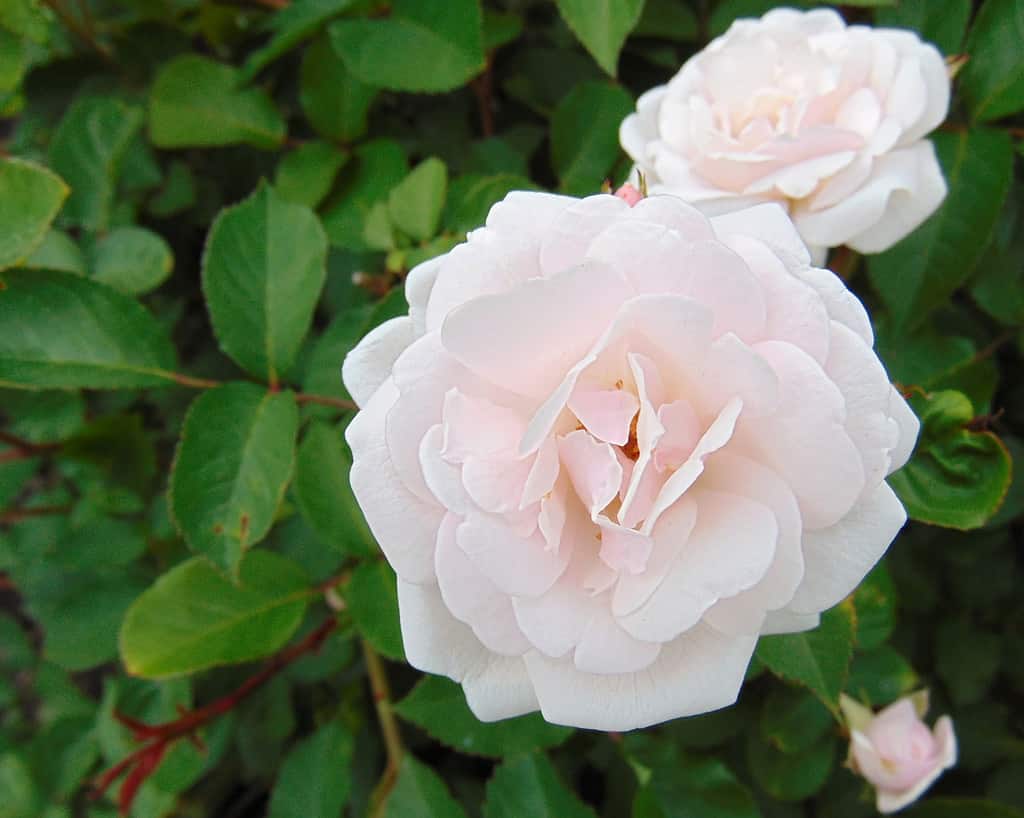
Marie Pavie flowers for ten months and repeats blooming its beautiful blush white flowers.
©Nadiatalent, CC BY-SA 3.0 <https://creativecommons.org/licenses/by-sa/3.0>, via Wikimedia Commons – License
7. Ebb Tide
Rich purple ebb tide is an unusual rose for South Carolina because its purple flowers are so dramatic, and its clove scent wafts across the yard.
The shrub is round, compact, and lush green, which makes excellent hedging, especially when the drama-filled flowers bloom in early spring to late fall.
Excellent disease resistance makes ebb tide one of the best standout trouble-free roses for South Carolina’s humid heat.
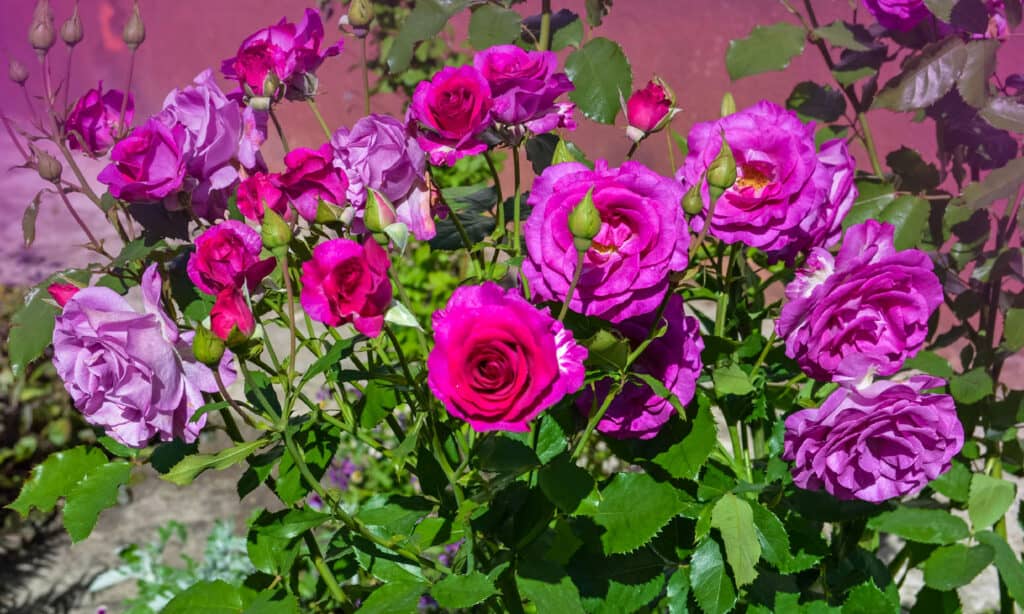
The shrub is round, compact, and lush, which makes excellent hedging, especially when the drama-filled flowers bloom in early spring to late fall.
©LesiChkalll27/Shutterstock.com
8. Belinda’s Dream
Belinda’s dream is a shrub rose developed in Texas in 1992 to withstand the south’s heat and humidity.
It’s an attractive, hardy rose with enormous four-inch double pink flowers that succession bloom across spring and summer. Disease-resistant foliage and flowers grow profusely across its voluptuous 5-foot-tall and wide stems. Belinda’s dream is a trouble-free, outstanding specimen rose for the borders of South Carolina gardens.
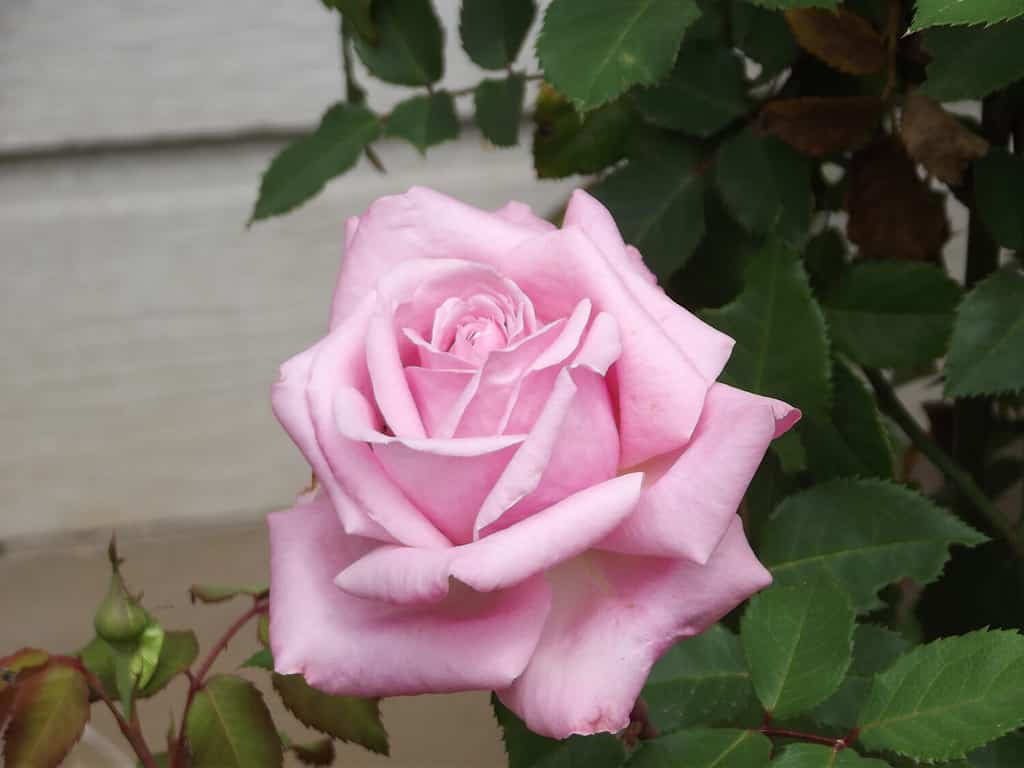
It’s an attractive, hardy rose with enormous four-inch double pink flowers that succession bloom across spring and summer.
©Excelementals/Shutterstock.com
9. Iceberg
Floribunda iceberg is a pure white rose available in either shrub or climbing form. It’s a knockout, trouble-free choice for South Carolina because it loves sunshine and copes well with humidity.
Gardeners love icebergs’ shiny green, disease-resistant foliage and honey-scented open flowers that attract pollinators. It blooms early in spring and keeps flowering until frost arrives. In warm areas, it can bloom year-round and doesn’t mind afternoon shade.
Plant up iceberg roses in a swathe because they look best in groups. Its unobtrusive color scheme pairs beautifully with companion plants like lavender or bright annual bedding blooms.

Iceberg roses are a stunning white, making them a standout in any garden or bouquet.
©Bonnie Taylor Barry/Shutterstock.com
How to Grow Roses in South Carolina
In South Carolina, lack of heat is never a problem for rose growers; the main issues to contend with are mildew and black spots, plus aphids, sawflies, and deer.
Here’s how to grow beautiful, trouble-free roses in South Carolina.
1. Choose a Sunny Spot
Roses like six to eight hours of full sun daily, so look for a sunny position. If you can’t manage six to eight hours, ensure roses bathe in the morning sun because it dries off overnight dew, which can lead to fungus.
2. Create Space
Plant your roses at least 2 feet apart, more for large shrub roses. Plenty of space creates good air circulation, essential in the fight against mildew.
3. Give Them the Best Soil
Roses are greedy, and they like lots of food and water! Ensure their soil is well drained, aerated, and loose before adding lots of well-rotted organic matter. Roses in thin or alkaline soil may develop yellow leaves due to nutrient deficiency.
4. Add Mulch
Mulch provides numerous benefits. It traps moisture, cuts down weed competition, provides nutrients, and stops diseased leaves from contaminating the growing medium. Mulch roses with well-rotted organic matter and keep topping them up throughout the growing season.
5. Water and Feed
When it comes to watering, it’s best to give South Carolina roses a thorough, deep watering once a week rather than a sprinkle every day. Roses in containers or raised beds need more regular water than border-grown roses. For trouble-free South Carolina roses, fertilize them weekly when the shrub is in flower. This ensures a vigorous plant that fights fungus and produces beautiful flowers until fall.
When to Plant Roses in South Carolina
The best time to plant South Carolina roses is late fall when the soil is still warm, and they have a whole winter ahead to establish their roots.
In South Carolina, getting enough soil depth to keep roots cool is important. Dig a hole big enough to comfortably contain all the roots and deep enough to cover the graft union. There is some debate about burying a graft union, but most rose experts agree it’s best below the soil line.
The Best Roses For South Carolina
The best roses for South Carolina can withstand drought, full sun, and mildew caused by humidity. The choices listed above are excellent South Carolinian roses, but whatever you choose, ensure they get lots of sunshine and air circulation space. Once planted, it’s down to you to water and fertilize them regularly to promote vigorous, healthy plants.
The photo featured at the top of this post is © Nagel Photography/Shutterstock.com
Thank you for reading! Have some feedback for us? Contact the AZ Animals editorial team.







